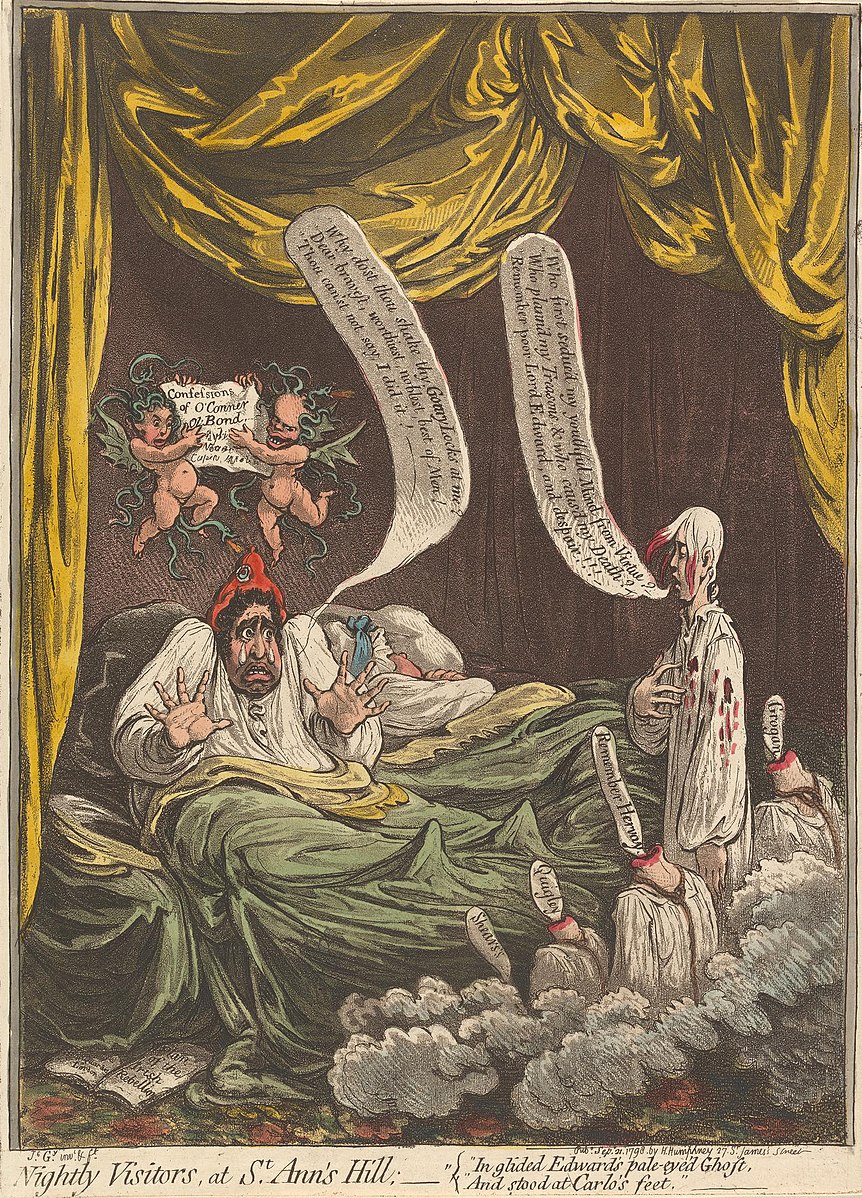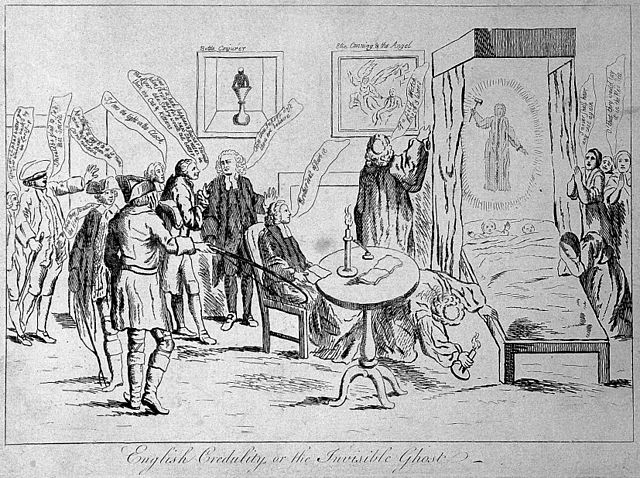Spectres in Print: Ghost Stories and Reading Habits
Written by Luke Holloway
The Market for Ghost Stories
Today, the ‘ghost story’ is usually a form of light-hearted entertainment, as most readers trust such encounters are fictitious. Three hundred years ago, however, the ghost story was treated with greater gravity. According to E. J. Clery, ‘the emergence of the supernatural into fiction’ occurred only in the later Georgian period. Even then, these tales continued to be seen as ‘evidence’ of the occult, despite their commercial role in the book market.1
The audience for supernatural fiction exploded in the late eighteenth century, due to the rises in literacy and the printing trade.2 Booksellers and libraries appeared throughout the British Isles, as the Industrial Revolution introduced new ways to manufacture and distribute literature.3 In turn, this revolutionised the nation’s reading habits, and ghost stories, for instance, became a collective past-time. As early as 1711, Joseph Addison, the founder of The Spectator, described a cluster of children telling such tales together:
I remember last Winter there were several young Girls of the Neighbourhood sitting about the Fire with my Land-lady’s Daughters; and telling Stories of Spirits and Apparitions… As one Spirit raised another, I observed that at the End of every Story the whole Company closed their Ranks and crouded about the Fire… this unaccountable Weakness in reasonable Creatures, who love to astonish and terrify one another.4
Spirituality and Scepticism
The supernatural became a leading genre in popular literature. Most notably, the ‘Graveyard School’ pioneered the themes of death and ghosts in eighteenth-century poetry. For example, David Mallet’s William and Margaret, written in the early 1720s, opened with the verse:
'TWAS at the silent, solemn hour,
When night and morning meet;
In glided MARGARET's grimly ghost,
And stood at WILLIAM's feet.5
This movement laid the foundations for both the Gothic and the Romantic literature of the late Georgian period, which included such renowned authors as Mary Shelley and Samuel Taylor Coleridge.6
The popularity of the ‘ghost story’ then served religious ends too. Responding to the empiricism of the Enlightenment, theologians presented these tales as ‘proof’ of divine intervention. In 1780, one preacher even dismissed the scepticism of Enlightenment thinkers as atheistic: ‘for when men come to deny the being of Spirits, the next step is to deny the being of God’. He also maintained that such stories were ‘the truth’, because they were told to him by other ‘religious persons’.7 Indeed, clergymen regularly corresponded with their colleagues to propagate these tales.8
The literary response was far from passive, however. The Enlightenment had contributed to a ‘public sphere’, as coffee-houses became a site of philosophical discourse. The sceptics thus sought to discredit each ‘ghost story’ through empirical study and lively debate.9 Their publications depicted ghostly encounters as illusory at best, and fraudulent at worst. In one text, James Lackington recounted a mistaken occasion when:
I saw, at some distance before, in the hedge, the dreadful apparition that had so terrified our company… the object much resembled the human figure as to shape, but the size was prodigious… I then perceived that it was only a very short tree, whose limbs had been newly cut off, the doing of which had made it much resemble a giant.10
The Case of Cock Lane
The Cock Lane affair exemplifies this clash. In London, William Kent and his spouse, Fanny Lynes, pretended that they were legitimately married and moved between different tenancies. Lynes died in February 1760, shortly after the couple had lodged at the residence of Richard Parsons in Cock Lane. Parsons then told John Moore, a local Methodist preacher, that Lynes’s ghost was creating noises at his house. The mystery became a media sensation. In 1762, a newspaper even surmised that Kent had poisoned Lynes for her inheritance, which ‘Scratching Fanny’ had now returned to expose. After much speculation, though, the sceptics revealed that Elizabeth, Parsons’s young daughter, was the real source of the sounds.11
The affair emphasises the popular fascination with the supernatural. Spectators had flocked to visit ‘Scratching Fanny’, including eminent figures like Horace Walpole and Samuel Johnson.12 The Methodists were also clearly eager to mobilise the mystery as ‘proof’ of divine intervention. Nevertheless, the sceptics ultimately won this case. As one broadside ballad recalled,
The Gentlemen return’d again,
And told young missy flat and plain,
She was the Agent of Cock-Lane,
Who knock’d and scratch’d for Fanny.13
Footnotes
- E. J. Clery, The Rise of Supernatural Fiction, 1762-1800 (Cambridge: Cambridge University Press, 1995), pp. 1, 24. Cambridge ebook.
- Ibid., pp. 5, 7.
- Sasha Handley, Visions of an Unseen World: Ghost Beliefs and Ghost Stories in Eighteenth-Century England (Abingdon: Routledge, 2016), p. 3. Taylor & Francis ebook.
- Joseph Addison, The Spectator, 12 (14 March 1711), 1-2 (p. 1).
- David Mallet, ‘William and Margaret’, in Eighteenth-Century Poetry Archive <https://www.eighteenthcenturypoetry.org/works/o5089-w0110.shtml#> [accessed 5 April 2021].
- Handley, Visions of an Unseen World, pp. 120, 122.
- Edmund Jones, A Relation of Apparitions of Spirits, in the Principality of Wales ([Trevecca?], 1780), pp. iii, ii. ESTC T130273.
- Laura Sangha, ‘The Social, Personal, and Spiritual Dynamics of Ghost Stories in Early Modern England’, The Historical Journal, 63.2 (2020), 339-59 (pp. 343, 344).
- Handley, Visions of an Unseen World, p. 3.
- James Lackington, An Account of Some Imaginary Apparitions, the Effects of Fear or Fraud. From Various Authors (Dunbar, [1792?]), p. 11. ESTC T66797.
- Handley, Visions of an Unseen World, pp. 142, 143, 144, 145.
- Misty G. Anderson, Imagining Methodism in Eighteenth-Century Britain: Enthusiasm, Belief, & the Borders of the Self (Baltimore, MD: Johns Hopkins University Press, 2012), pp. 158, 159. ProQuest ebook.
- Cock Lane, Humbug ([London?], [1762?]), British Library Roxburghe C.20.f.9.667, EBBA 31387.
Primary Sources:
Addison, Joseph, The Spectator, 12 (14 March 1711), 1-2.
Cock Lane, Humbug ([London?], [1762?]), British Library Roxburghe C.20.f.9.667, EBBA 31387.
[Hester Ann Rogers?] to Elizabeth Ritchie, c. 1788, Manchester Methodist Archives, MAM/FL/33/4.
Jones, Edmund, A Relation of Apparitions of Spirits, in the Principality of Wales ([Trevecca?], 1780). ESTC T130273.
Lackington, James, An Account of Some Imaginary Apparitions, the Effects of Fear or Fraud. From Various Authors (Dunbar, [1792?]). ESTC T66797.
Mallet, David, ‘William and Margaret’, in Eighteenth-Century Poetry Archive <https://www.eighteenthcenturypoetry.org/works/o5089-w0110.shtml#> [accessed 5 April 2021].
Secondary Sources:
Anderson, Misty G., Imagining Methodism in Eighteenth-Century Britain: Enthusiasm, Belief, & the Borders of the Self (Baltimore, MD: Johns Hopkins University Press, 2012). ProQuest ebook.
Barry, Jonathan, ‘News from the Invisible World: The Publishing History of Tales of the Supernatural c. 1660-1832', in Cultures of Witchcraft in Europe from the Middle Ages to the Present, ed. by Jonathan Barry, Owen Davies and Cornelie Usborne (Cham: Palgrave Macmillan, 2018), pp. 179-212. Springer ebook.
Clery, E. J., The Rise of Supernatural Fiction, 1762-1800 (Cambridge: Cambridge University Press, 1995). Cambridge ebook.
Davies, Owen, ‘Wesley’s Invisible World: Witchcraft and the Temperature of Preternatural Belief’, in Perfecting Perfection: Essays in Honour of Henry D. Rack, ed. by Robert Webster (Cambridge: The Lutterworth Press, 2015), pp. 147-72.
Handley, Sasha, Visions of an Unseen World: Ghost Beliefs and Ghost Stories in Eighteenth-Century England (Abingdon: Routledge, 2016). Taylor & Francis ebook.
Sangha, Laura, ‘The Social, Personal, and Spiritual Dynamics of Ghost Stories in Early Modern England’, The Historical Journal, 63.2 (2020), 339-59.
E-Resources:
‘Discovering Literature: Romantics & Victorians’ from the British Library, at https://www.bl.uk/romantics-and-victorians/themes/the-gothic.
Images:
'Complete contemporary history of Cock Lane Ghost Wellcome L0030583', <https://commons.wikimedia.org/wiki/File:Complete_contemporary_history_of_Cock_Lane_Ghost_Wellcome_L0030583.jpg> [accessed 7 June 2021].
'James Gillray - Nightly Visitors, at St. Ann's Hill, In Glided Edward's Pale-Eye'd Ghost, and Stood at Carlo's Feet - B1981.25.899 - Yale Center for British Art', <https://commons.wikimedia.org/wiki/File:James_Gillray_-_Nightly_Visitors,_at_St._Ann%27s_Hill,_In_Glided_Edward%27s_Pale-Eye%27d_Ghost,_and_Stood_at_Carlo%27s_Feet_-_B1981.25.899_-_Yale_Center_for_British_Art.jpg> [accessed 7 June 2021].

A depiction of ghosts in Georgian print: James Gillray, Nightly Visitors, at St. Ann's Hill (1798).

'English Credulity or the Invisible Ghost', an engraving of the Cock Lane affair.
